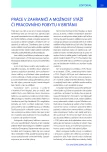RECOMMENDATIONS FOR DIAGNOSIS AND MANAGEMENT OF NOCTURIA IN THE CZECH REPUBLIC
Authors:
Roman Zachoval 1; Jan Krhut 2,3; Miroslav Krhovský 4
Authors‘ workplace:
Urologické oddělení, Thomayerova nemocnice a 1. LF a 3. LF UK Praha
1; Urologické oddělení, Fakultní nemocnice Ostrava
2; Katedra chirurgických oborů LF OU Ostrava
3; Urologické oddělení, Nemocnice Kyjov
4
Published in:
Ces Urol 2016; 20(4): 285-292
Category:
Guidelines
Overview
Nocturia is defined as the complaint that the individual has to wake at night one or more times for voiding. Nocturia is one of the lower urinary tract symptoms (LUTS) and it is frequently the first symptom to be complained about when seing a physician. Nocturia can also be regarded as a clinical syndrome with complex and multifactorial ethiopathogenesis. The most frequent cause of nocturia is nocturnal polyuria (NP). The prevalence of nocturia is high and it is increasing with the age of patients. Nocturia is associated with a number of serious health conditions, such as fatigue, risk of falling and skeletal fractures, heart failure etc. Nocturia has also an essential impact on quality of life. Despite high prevalence and enormous clinical significance no specific recommendations for nocturia management have been established. The aim of this paper is to define recommendations for diagnostic work up and treatment of nocturia in the milieu of the Czech Republic health care system.
Key words:
Nocturia, nocturnal polyuria, lower urinary tract, quality of life.
Sources
1. van Kerrebroeck P, Abrams P, Chaikin D, et al. Standardisation Sub-committee of the International Continence Society. The standardisation of terminology in nocturia: report from the Standardisation Sub‑committee of the International Continence Society. Neurourol Urodyn. 2002; 21(2): 179–178.
2. Weiss JP, Blaivas JG, Bliwise DL, et al. The evaluation and treatment of nocturia: a consensus statement. BJU Int. 2011 Jul; 108(1): 6–21.
3. Schatzl G, Temml Ch, Schmidbauer J, et al. Cross-sectional study of nocturia in both sexes: analysis of a voluntary health screening project. Urology 2000; 56: 71–75.
4. Weiss JP, Blaivas JG. Nocturia. J Urol 2000; 163: 5–12.
5. Weiss JP. Prevalence of nocturnal polyuria in nocturia. J Urol 2009; 181(Suppl 4): 538.
6. Abraham L, Hareendran A, Mills IW, et al. Development and validation of a quality-of-life measure for men with nocturia. Urology 2004; 63: 481–486.
7. Krhut J, Zachoval R, Smith PP, Rosier PF, Valansky V, Martan A, Zvara P. Pad weight testing in the evaluation of urinary incontinence. Neurourol Urodyn 2014; 33(5): 507–510.
8. Hashim H, Abrams P. Nocturia. Oxford Urology Library. Oxford University Library 2015. ISBN: 9780198719113.
9. Bosch JLHR, Everaert K, Weiss JP, et al. Would a new definitiv and classification of nocturia and nocturnal polyuria improve our management of patiens? ICI-RS 2014. Neurourol Urodyn 2016; 35: 283–287.
10. Reynard JM, Cannon A, Yang Q, Abrams P. A novel therapy for nocturnal polyuria : a double-blind randomized trial of frusemid against placebo. BJU 1998; 81: 215–218
11. Pedersen PA, Johansen PB. Prophylactic treatment of adult nocturia with bumetanide. BJU 1988; 62: 145–147.
12. Fu FG, Lavery HJ, Wu DL. Reducing nocturia in the elderly: a randomized placebo-controlled trial of staggered furosemide and desmopressin. Neurourol Urodyn. 2011; 30(3): 312–316.
Labels
Paediatric urologist Nephrology UrologyArticle was published in
Czech Urology

2016 Issue 4
Most read in this issue
- PROGNOSTIC SIGNIFICANCE OF PARAMETERS ARISING FROM THE RATIO OF NEUTROPHILS AND LYMPHOCYTES IN INVASVIE BLADDER NEOPLASMS
- BLADDER SPARING TREATMENT FOR MUSCLE-INVASIVE BLADDER CANCERS
- URINARY SYMPTOMS IN PATIENTS WITH MULTIPLE SCLEROSIS. AS UROLOGISTS, ARE WE IMPORTANT IN THE ALGORITHM OF SPECIALIZED CARE OF PATIENT WITH MULTIPLE SCLEROSIS?
- HIBERNOMA AS A SURPRISING FINDING DURING PERIRENAL TUMOUR EXSTIRPATION
